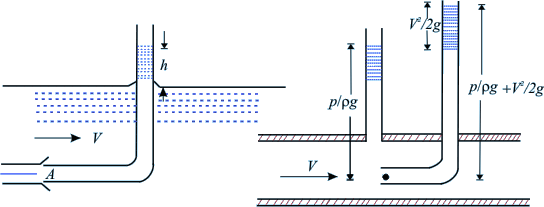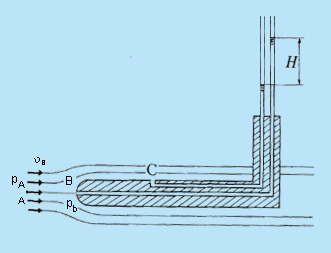|
Pitot Tube for Flow Measurement
Construction:
The principle of flow measurement by Pitot tube was adopted
first by a French Scientist Henri Pitot in 1732 for measuring
velocities in the river. A right angled glass tube, large
enough for capillary effects to be negligible, is used for
the purpose. One end of the tube faces the flow while the
other end is open to the atmosphere as shown in Fig. 16.3a.
Working:
- The liquid flows up the tube and when
equilibrium is attained, the liquid reaches a height above
the free surface of the water stream.
- Since the static pressure, under
this situation, is equal to the hydrostatic pressure due
to its depth below the free surface, the difference in level
between the liquid in the glass tube and the free surface
becomes the measure of dynamic pressure. Therefore, we can
write, neglecting friction,

where p0,
p and V are the stagnation pressure, static
pressure and velocity respectively at point A (Fig. 16.3a).

- Such a tube is known as a Pitot tube
and provides one of the most accurate
means of measuring the fluid velocity.

Fig 16.3 Simple
Pitot Tube (a) tube for measuring the Stagnation Pressure
(b) Static and Stagnation tubes together
- For an open stream of liquid with
a free surface, this single tube is suffcient to determine
the velocity. But for a fluid flowing through a closed duct,
the Pitot tube measures only the stagnation pressure and
so the static pressure must be measured separately.
- Measurement of static pressure in this
case is made at the boundary of the wall (Fig. 16.3b). The
axis of the tube measuring the static pressure must be perpendicular
to the boundary and free from burrs, so that the boundary
is smooth and hence the streamlines adjacent to it are not
curved. This is done to sense the static pressure only without
any part of the dynamic pressure.
- A Pitot tube is also inserted as shown
(Fig. 16.3b) to sense the stagnation pressure. The ends
of the Pitot tube, measuring the stagnation pressure, and
the piezometric tube, measuring the static pressure, may
be connected to a suitable differential manometer for the
determination of flow velocity and hence the flow rate.
Pitot Static Tube
- The tubes recording static pressure
and the stagnation pressure (Fig. 16.3b) are usually combined
into one instrument known as Pitot static tube (Fig.
16.4).

Fig 16.4 Pitot
Static Tube
- The tube for sensing the static pressure
is known as static tube which surrounds the pitot tube that measures the stagnation pressure.
- Two or more holes are drilled radially through the outer
wall of the static tube into annular space. The position of these static holes is
important. Downstream of the nose N, the flow is accelerated somewhat with
consequent reduction in static pressure. But in front of the supporting stem,
there is a reduction in velocity and increase in pressure.
- The static holes
should therefore be at the position where the two opposing effects are counterbalanced
and the reading corresponds to the undisturbed static pressure.
Finally the flow velocity is given by
 |
(16.9) |
where ∆p is the difference between stagnation and static pressures.
- The factor C takes care of the non-idealities,
due to friction, in converting the dynamic head into pressure
head and depends, to a large extent, on the geometry of
the pitot tube. The value of C is usually determined from
calibration test of the pitot tube.
|